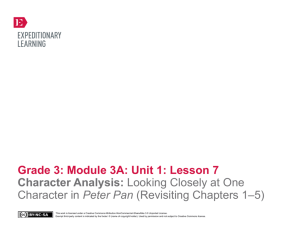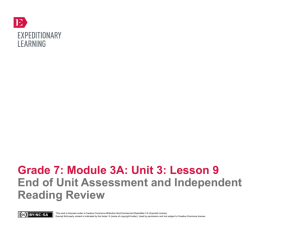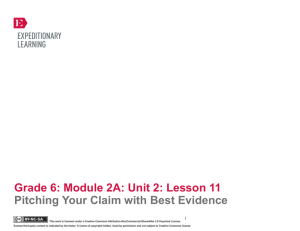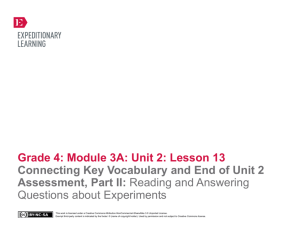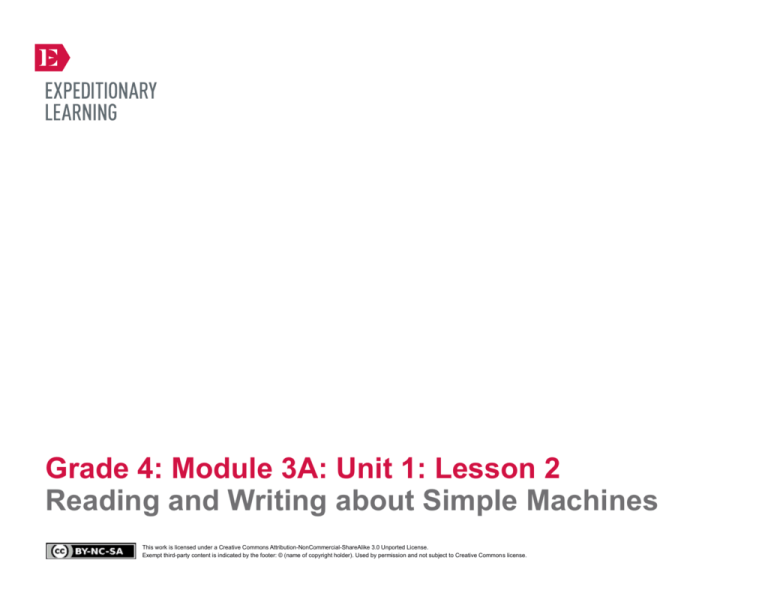
Grade 4: Module 3A: Unit 1: Lesson 2
Reading and Writing about Simple Machines
This work is licensed under a Creative Commons Attribution-NonCommercial-ShareAlike 3.0 Unported License.
Exempt third-party content is indicated by the footer: © (name of copyright holder). Used by permission and not subject to Creative Commons license.
GRADE 4: MODULE 3A: UNIT 1: LESSON 2
Reading and Writing about Simple Machines
Long-Term Targets Addressed (Based on NYSP12 ELA CCLS)
I can explain the main points in a historical, scientific, or technical text, using specific details in the text. (RI. 4.3)
I can determine the main idea using specific details from the text. (RI.4.2)
I can document what I learn about a topic by taking notes. (W.4.8)
Supporting Learning Targets
Ongoing Assessment
• I can determine the main idea of a scientific text.
• Simple Machines Science journal (page 8, Building
Background Knowledge)
• I can write a paragraph describing what simple machines do using details from the text.
Agenda
Teaching Notes
1. Opening
• In advance: Have the directions for Partner Reading ready to share.
A. Engaging the Reader: Discussion of the Guiding
Question (5 minutes)
• Create the guiding question anchor chart with the question: “How do simple machines impact our
lives?” on it, written large.
B. Reviewing Learning Targets (5 minutes)
• Post: Learning targets.
2. Work Time
A. Review and Identify Main Idea in a Scientific Text
(10 minutes)
B. Partner Reading: Supporting Details (15 minutes)
C. Writing Like a Scientist (15 minutes)
3. Closing and Assessment
A. Browsing and Selecting Independent Reading Books
(5 minutes)
B. Reflecting on Learning Targets (5 minutes)
4. Homework
Copyright © 2013 by Expeditionary Learning, New York, NY. All Rights Reserved.
NYS Common Core ELA Curriculum • G4:M3A:U1:L2 • June 2014 •
1
GRADE 4: MODULE 3A: UNIT 1: LESSON 2
Reading and Writing about Simple Machines
Lesson Vocabulary
Materials
determine, main idea, scientist,
scientific text, simple machines, work,
force, effort
• Guiding Question anchor chart (new; teacher-created; see teaching notes)
• Sticky notes (2-3 per student)
• Equity sticks
• Simple Machines: Forces in Action (book; one per student plus one for teacher use)
• Science journal (one per student; from Lesson 1)
• Document camera
• Directions for Partner Reading (one per student)
• Homework for Simple Machines: Forces in Action, pages 4–5 (one per student)
Opening
Meeting Students’ Needs
A. Engaging the Reader: Discussion of the Guiding Question (5 minutes)
• Remind students that for the next few weeks they will be reading and writing like scientists and learning all about simple
machines. Direct students’ attention to the Guiding Question anchor chart: “How do simple machines impact our
lives?”
• Consider coming up with a visual
cue for the word main idea that you
hold up each time you read this
word. This will help your ELLs
make connections to this word from
previous learning.
• Ask students to think about their response and Write-Pair-Share on a sticky note. Use equity sticks to call on a few
students to share out something their partner said. As they share their thinking, have them hand in their sticky note with the
date next to their response. Tell students they will revisit this chart throughout the module, adding new thinking as their
learning progresses.
B. Reviewing Learning Targets (5 minutes)
• Invite students to read the learning target: “I can determine the main idea of a scientific text.”
• Underline the phrase main idea. Ask students to reflect with a partner on a time the class has discussed main idea. Students
should recall identifying the main idea in the texts they read about the Iroquois earlier in the year (see Module 1, Unit 2,
Lesson 2). Remind students that the main idea is the most important idea from the text. Circle the word determine and ask
them to share with their group what they think the word means. Have groups share out and clarify that determine means:
“to decide after thinking.” Tell students they will decide, or determine, the main idea using details to support their decision.
Copyright © 2013 by Expeditionary Learning, New York, NY. All Rights Reserved.
NYS Common Core ELA Curriculum • G4:M3A:U1:L2 • June 2014 •
2
GRADE 4: MODULE 3A: UNIT 1: LESSON 2
Reading and Writing about Simple Machines
Work Time
Meeting Students’ Needs
A. Review and Identify Main Idea in a Scientific Text (10 minutes)
• Consider placing gist cards on each
table. This could be a gist sentence
generated from the previous day’s
lesson. This may help your
struggling readers focus on the most
important parts of the text.
• Distribute the text Simple Machines and the Simple Machines Science journal to each student.
• Inform the students today they’ll reread the same pages they read during Lesson 1 (pages 4–5) to determine the main idea.
Remind them that they have read for the main idea before and the graphic organizer on page 8 of their Simple Machines
Science journal should look familiar (first introduced in Module 1, Unit 2, Lesson 2). Point out the box for recording the
main idea and boxes for recording supporting details.
• Invite students to reread the text out loud with a partner and discuss what they think the main idea of the text is.
• Use equity sticks to call on pairs to share their main ideas. Using a document camera, model recording the main idea in
the graphic organizer on page 8 of the Simple Machines Science journal, titled “Building Background Knowledge: What Are
Simple Machines?” A possible main idea from the text could be: “Machines have been used in the past and present to help
people do work,” or “Simple machines help people past and present to do work.” Direct the students to write the main idea
in the graphic organizer of their researcher’s notebook. Students can copy the exact phrasing that is written on the class
chart, or they can put it in their own words.
Copyright © 2013 by Expeditionary Learning, New York, NY. All Rights Reserved.
• It may help your ELLs or struggling
readers to pair with students
reading at higher levels to discuss
the main idea and supporting
details.
NYS Common Core ELA Curriculum • G4:M3A:U1:L2 • June 2014 •
3
GRADE 4: MODULE 3A: UNIT 1: LESSON 2
Reading and Writing about Simple Machines
Work Time (continued)
Meeting Students’ Needs
B. Partner Reading: Supporting Details (15 minutes)
• Inform students they will again read pages 4 to 5 in the book to identify details supporting the main idea of the text and
record into the next three boxes of their graphic organizers. Briefly review the Topic Expansion graphic organizer (which
students should recognize from Module 1, Unit 2, Lesson 2). Post and hand out copies of the Directions for Partner
Reading:
• Providing students with highlighters
to find supporting details may help
them identify the information they
need in the text.
1. Take turns rereading the text paragraph by paragraph.
2. Look for details that support the main idea.
• Consider underlining the words in
bold and including visuals next to
each step.
3. Record three details that best support the main idea into the middle boxes of your graphic organizer (use notes or
phrases, not sentences).
4. Synthesize what you have learned by answering the question in the box on the right of the graphic organizer.
5. Stop: We will answer the question at the bottom of page 8 together later in this lesson.
• Give students at least 10 minutes to reread and record.
• Invite each pair to join another pair to share the details they have identified supporting the main idea. Some details they may
identify could be: “In ancient Egypt, workers used levers to lift heavy blocks to put them in the right spot,” or “As the
pyramids grew taller, the workers built ramps to move the heavy blocks to a higher level of the pyramid.”
C. Writing Like a Scientist (15 minutes)
• Explain to students that they will now use their graphic organizer to write a paragraph on page 8 of their Science journals
that expresses the main idea and details of the portion of the text they read. Ask them to read the second learning target: “I
can write a complete paragraph describing what simple machines do using details from the text.” Ask them what it means to
write a “complete paragraph.” Jot their thinking down above the words in the learning target for clarification. Explain to
students that after they have read the text and determined the main idea, they will write a paragraph describing what simple
machines do.
• Using paragraph frames can help
ELLs articulate their learning. For
example: “Simple machines are
______. One of the ways simple
machines help people is ______.
Another way simple machines help
people is ______.”
• Remind students of the work they did writing paragraphs in Modules 1 and 2. Remind them that the characteristics of a
quality paragraph are: a topic sentence, supporting details, and a concluding sentence.
• Give students 10 minutes of work time to write one paragraph.
Copyright © 2013 by Expeditionary Learning, New York, NY. All Rights Reserved.
NYS Common Core ELA Curriculum • G4:M3A:U1:L2 • June 2014 •
4
GRADE 4: MODULE 3A: UNIT 1: LESSON 2
Reading and Writing about Simple Machines
Meeting Students’ Needs
Closing and Assessment
A. Browsing and Selecting Independent Reading Books (5 minutes)
• Allow students time to select a book from the recommended texts for this unit for independent reading. Let students know
that you expect them to read at home from this book and will be asked to do so for homework as well as in class. Be sure to
assist students in selecting a book at their independent reading level.
B. Reflecting on Learning Targets (5 minutes)
• Direct students’ attention to the second learning target: “I can use details from the text to explain what simple machines do
using details from the text.” Ask students to Think-Pair-Share about how successful they were in meeting this learning
target. Make sure they show evidence from their paragraphs to support their reflection.
• Remind students that tomorrow they will be assessed on the learning targets they used today. On the assessment they will be
asked to identify the main idea of new scientific text about simple machines and write a paragraph explaining how simple
machines are used.
Meeting Students’ Needs
Homework
• Review pages 4 to 5 in Simple Machines: Forces in Action. Answer the question on the Homework for Simple
Machines: Forces in Action, pages 4–5 handout using evidence from the text.
• Begin to read from the independent reading book you selected for this unit.
Copyright © 2013 by Expeditionary Learning, New York, NY. All Rights Reserved.
NYS Common Core ELA Curriculum • G4:M3A:U1:L2 • June 2014 •
5
Grade 4: Module 3A: Unit 1: Lesson 2
Supporting Materials
This work is licensed under a Creative Commons Attribution-NonCommercial-ShareAlike 3.0 Unported License.
Exempt third-party content is indicated by the footer: © (name of copyright holder). Used by permission and not subject to Creative Commons license.
GRADE 4: MODULE 3A: UNIT 1: LESSON 2
Directions for Partner Reading
Directions for creating: Write the following underneath on chart paper to create this anchor chart.
1. Take turns rereading the text paragraph by paragraph.
2. Look for details that support the main idea.
3. Record three details that best support the main idea into the middle boxes of your graphic
organizer (use notes or phrases, not sentences).
4. Stop: We will complete last box and answer the question at the bottom of page 4 in the next lesson.
Copyright © 2013 by Expeditionary Learning, New York, NY. All Rights Reserved.
NYS Common Core ELA Curriculum • G4:M3A:U1:L2 • June 2014 •
7
GRADE 4: MODULE 3A: UNIT 1: LESSON 2
Homework for Simple Machines:
Forces in Action, pages 4–5
Name:
Date:
Read pages 4–5 in Simple Machines: Forces in Action again. The text says: “Effort is a force acting
on an object that moves the object.” Explain what this sentence means using evidence from the text to
support your thinking.
Copyright © 2013 by Expeditionary Learning, New York, NY. All Rights Reserved.
NYS Common Core ELA Curriculum • G4:M3A:U1:L2 • June 2014 •
8









